2025-11-05 01:44:00
Like millions of others, I’ve been watching and playing with OpenAI’s new video model, Sora—and I keep thinking about how often technology outpaces permission. One week it’s coffee apps; the next, it’s cinematic worlds spun from text. Each innovation starts as convenience and ends up rewriting the rules.
Starbucks didn’t mean to become a financial institution. But every era of innovation finds its own way to test the rules.
The world runs on rules. But rules run on paperwork, committees, and calendars. Technology, on the other hand, runs on curiosity and caffeine.
That mismatch—between how fast people can build and how slowly institutions can respond—has become one of the defining forces of modern life. It’s not that people are breaking the law; it’s that the law no longer describes what people are doing.
Starbucks is a coffee company. But in financial terms, it’s also one of the largest banks in America. Customers collectively hold nearly $2 billion in prepaid balances on Starbucks cards and apps—more than 85 percent of U.S. banks hold in total deposits.
The twist is that customers didn’t entirely choose this setup. When you pay with the Starbucks app, you can’t simply use your credit card in the moment. You have to preload money into an account. That single design choice—subtle, convenient, and completely intentional—turned every latte purchase into a micro-deposit. Starbucks quietly became a financial institution without ever applying for a banking license.
This is how change usually happens in technology: not through rebellion, but through design. What begins as a product feature becomes a regulatory blind spot, and over time, an accepted norm.
If Starbucks represents the subtle version of this phenomenon, Uber is its loud, brash archetype.
Uber wrote the modern playbook for testing the limits of regulation. Launch first, operate in the gray, and let adoption create legitimacy. By the time regulators react, public opinion—and billions in rider demand—make reversal almost impossible.
Uber’s true innovation wasn’t just the app itself. It was the recognition that once technology hits a certain scale, the question shifts from “Is this allowed?” to “How do we live with it?” That approach—move fast, find the edges, let the system adapt—has become the default operating system of the modern tech economy. Starbucks, in its own quiet way, followed it. So have crypto networks, prediction markets, and now, artificial intelligence companies.
OpenAI’s new video model, Sora, can generate cinematic footage from a text prompt. It’s astonishing. But behind that wonder lies a familiar discomfort: whose work did it learn from?
The model didn’t invent its sense of movement, light, and storytelling in isolation. It absorbed it—from films, animation, design, and photography created by millions of people who were never asked, credited, or compensated. The company insists this is legal, and perhaps under current law it is. But legality and legitimacy are not the same thing.
Copyright law wasn’t built for an era when a machine could absorb the collective visual memory of humanity. It was written for a world where “copying” meant pressing paper or burning film. The law still speaks the language of ownership. The technology now speaks the language of ingestion.
That gap—between what’s legal and what’s right—is where power quietly accumulates.
For most of history, invention was the bottleneck. Today, interpretation is. Regulators deliberate in years; developers iterate in days. By the time the rules catch up, the loophole has become the market.
We still talk about regulation as if it defines the edges of what’s possible. Increasingly, it just describes what people already decided to do. But acceptance and fairness are not the same thing. Just because something scales doesn’t mean it should.
As formal oversight struggles to keep pace, informal ones have stepped in: reputation, public trust, user backlash. They’re faster than legislation, but also more fragile.
The world needs builders bold enough to test limits, but principled enough to remember why those limits existed in the first place. Progress that erases the people it depends on isn’t progress—it’s extraction.
Every major leap forward begins in a gray area. Railroads, credit cards, the internet—all bent old rules until society decided whether to rewrite them or live with the consequences. Artificial intelligence is just the latest in that lineage.
The challenge isn’t stopping innovation; it’s ensuring that the people writing the future still feel accountable to the ones living in it. The future doesn’t always ask for permission. But maybe it should still ask for consent.
2025-10-08 23:25:00
After winning a Golden Globe in 2006, Phillip Seymour Hoffman replied to a question about how he got to this moment in his life.
Nearly two decades later, his response is more relevant than ever.
“Even if you are auditioning for something you know you don’t like or are never going to get, whenever you get a chance to act in a room that someone else has paid for, it is a free chance to practice your craft. And in that moment, you should act as well as you can because if you leave that room and you have done this, there is no way the people who watched you will forget it. That is the only advice I have because it is always about that — if you are given the chance to act, take those words and bring them alive; and if you do that, something will ultimately transpire.”
This mindset explains how within two years, Hoffman played Sandy Lyle in Along Came Polly and Truman Capote in Capote, winning an Oscar for the latter.

Retired United States Navy General William McRaven echoed a similar sentiment in his book, The Wisdom of the Bullfrog, writing,
“I found in my career that if you take pride in the little jobs, people will think you worthy of the bigger jobs.”
He illustrated this point with a story from early in his career when rather than being assigned to lead a mission, he was tasked with building a float that would represent the Navy SEALs (often referred to as “frogmen”) in the Fourth of July parade.

After receiving the assignment, McRaven was admittedly dejected. In his mind, he had joined the Navy SEALs to lead missions, not build parade floats. But a seasoned team member offered him a quiet piece of advice, saying:
“Sooner or later we all have to do things we do not want to. But if you are going to do it, do it right. Build the best damn Frog Float you can.”
McRaven took the message to heart, pouring himself into the task and the float went on to win first prize in its category.
Over time, McRaven would lead far more consequential missions, including commanding the Joint Special Operations Command (JSOC) and later the U.S. Special Operations Command (SOCOM), which oversees all U.S. special operations forces, including the Navy SEALs, Army Green Berets, and Air Force Pararescue.
Unfortunately, I didn’t appreciate this lesson enough early in my career. As an example, after graduating from business school, I thought I could come right in and impart my newly found wisdom, when I should have been a better listener and executed the mundane tasks with as much vigor as the more interesting ones.
Fortunately, I don’t think I am alone. If I had to guess, anyone reading this can point to a similar moment in their career.
The thing is, this happens to all of us. Even the very best.
Look no further than Tom Brady, who has admitted he was consumed by this mentality early in his career at Michigan.
After his sophomore season, Brady was buried on the depth chart, only getting one or two reps per practice. As a result, he expressed his frustration to the coaches, to which head coach Lloyd Carr responded,
“Brady, I want you to stop worrying about what all the other players on our team are doing. All you do is worry about what the starter is doing, what the second guy is doing, what everyone else is doing. You don’t worry about what you are doing. You came here to be the best. If you’re going to be the best, you have to beat out the best.”
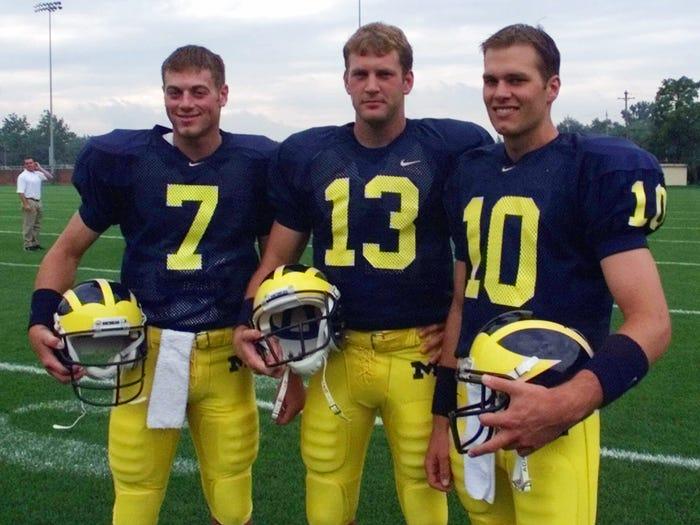
Carr then suggested Brady meet with Greg Harden, a counselor in the athletic department.
Once again, Brady vented his frustration — complaining about getting limited reps.
Harden’s advice was simple:
“Just focus on doing the best you can with those two reps. Make them as perfect as you possibly can. Then focus on the next two, and the next two, and the next two.”
How did Brady respond?
In his words,
“So, that’s what I did. They would put me in for those two reps, and man, I would sprint out there like it was the Super Bowl. I’d shout, ‘Let’s go boys! Here we go! What play we got?!?’ And I started to do really well with those two reps because I brought enthusiasm and energy. Soon, I was getting four reps. Then ten, and before you knew it, with this new mindset that Greg had instilled in me — to focus on what you can control, to focus on what you’re getting, not what anyone else is getting. To treat every rep like it’s the Super Bowl — eventually, I became the starter.”
We all know how Brady’s story played out from here, and it all started with two reps.
Last spring, my then eight-year-old son was wrestling with getting to play very limited minutes, so I read him this story about Brady. After sitting in silence for a few seconds, he looked up at me and said, “Tom Brady barely played too??”
To which I responded, “Yeah bud, like you. You just gotta make the best of your chances you’re given.”
After leaving his room that night, I thought to myself — I would give just about anything to be able to go back in time and tell my younger self this.
Would I have listened?
I hope so, but if this is a hard concept for adults to grasp, I imagine it’s even more difficult for kids.
Nonetheless, I wish I had appreciated this fact of life earlier. The fact is, someone is almost always watching, so it’s worth treating everything you do with purpose and pride. And, even if no one has their eyes on you, it is still a chance to “practice your craft”. To improve. To build strong habits.
Since time is limited, we only get so many opportunities.
We might as well take advantage of each one we get.
2025-09-18 05:52:00
The beginning of a new school year is a unique time in every kid’s life. A time full of expectations, and equal amounts of trepidation and excitement. The same could be said for their parents, which is why I was struck by this list of suggestions that a lower school head wrote for a back-to-school night.
Parents,
A few suggestions for the upcoming school year:
1. Try to remain objective about your child and realistic about your expectations. We are not talking here about loving your child any less — just about viewing his strengths and limitations in a realistic way.
2. Keep yourself well-informed and open to the observations of others about your child. Such people as teachers and coaches can provide you with valuable pieces of information, and you need to take the time to listen.
3. Accept “bad news” as a problem to be dealt with. Do everything you can to keep yourself from overreacting. Keep calm and think! Remember that even we parents have made a mistake or two along the way.
4. Listen carefully to your children, but make the distinction between listening to them and agreeing with them. Kids are good at conveying a perspective. Don’t succumb to the temptation to equate the child’s perspective with “the truth.”
5. Leave the child some unscheduled time. You would be surprised to see the number of kids who can’t seem to do anything unless it’s been planned and scheduled for them. Remember the old days when we had to determine for ourselves some of the things we were going to do with our time.
6. Act consistently over time; and, mothers and fathers, act together. Don’t make empty threats. Don’t let children play off one parent against the other.
Our main goal is to help your child develop into an intelligent, thoughtful, compassionate, contributing adult — a person who years from now is able to say to themselves: “I have the capacity to make sound decisions and to work through obstacles on my own.” The decisions you make along the way can serve either to enhance or reduce the probability that the goal will be reached.
For any parent who read this, it probably resonated. It did for me at least.
Now, what if I let you in on a little secret?
What if I told you this was written in 1992??
I’ll be honest, when I first read it, I was both surprised and relieved. Surprised because it is almost exactly what I would expect a head of school to suggest for parents in 2025. Relieved because it is a reminder that one thing that never changes over time is human behavior.
While this list pertains to how we parent our kids, it could apply to many other things in life — including business and investing.
#1 — Remain objective and realistic about your expectations
Parents have wrestled with this challenge for generations, and likely always will. It’s only natural to want the best for our children, and to want the best from them as well. Yet the truth is, true greatness is the exception, not the rule. However, recognizing that reality feels harder today than ever before.
The reason?
In part because social media’s curated clips of kids scoring goals, acing tests, mastering instruments, and winning awards convince parents that their own kids are lagging. They subsequently pile on more coaching, tutoring, and specialization, which unfortunately has a better chance of breeding burnout than greatness.
Many investors today are suffering from something similar, evidenced by the rise in the popularity of riskier investments like private equity, leveraged ETFs, and crypto, while others are increasingly falling for “get-rich-quick” schemes.
Why?
For the same reasons parents lose their objectiveness. Whether it’s seeing Jeff Bezos on his yacht, the women in The Real Housewives of Name that City, or social media photos of people on vacation in exotic locales, many people feel they have missed out on the outsized returns over the past decade and are trying to catch up.
This is precisely the reason the late Charlie Munger said, “it’s not greed that drives the world, it’s envy.”
The trouble is that when people take outsized risks at this stage of a cycle, it almost always doesn’t end well.
#2 — Stay well-informed and open to observations
Being “well-informed” seems to mean something different than it used to, in large part due to the speed at which information travels. For parents, it used to mean knowing their kids’ general whereabouts and trusting they’d be home by dark. Now, it involves tracking their every move with GPS. As for openness to feedback, since many now take offense, teachers and coaches often hesitate to provide it, hindering kids’ growth.
For investors, it used to mean being well-read and having a good sense of where the world was headed. Today, it too often means being aware of what is happening every minute of every hour of every day through outlets like Twitter and Bloomberg. Unfortunately, this deluge of information has made many “miss the forest for the trees,” leading to increased turnover and worse performance.

#3 — Accept “bad news” as a problem to be dealt with and don’t overreact
An inability to accept that bad grades are a part of life has led to one of the greatest overreactions in the history of education — grade inflation.
The result?
No one knows how kids are truly doing, notably colleges and employers. As a result, to gain admission, kids feel like they need to differentiate themselves in other ways, so they overload on countless activities outside of school. Yet, GPAs are still higher than ever.
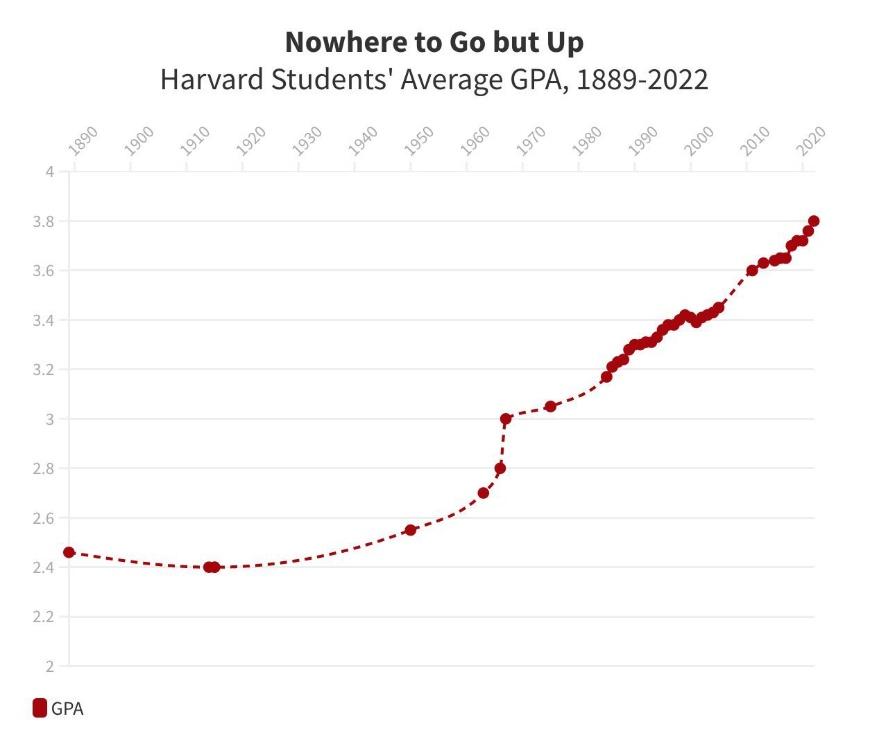
Investors hate bad news too, only instead of grade inflation, we have experimented with illiquidity as a solution to the volatility created by negative headlines in public markets. The problem is, volatility is often what creates the best investment opportunities, at least for those able to take advantage of it. Given this push for illiquidity has become so widespread, we are just beginning to witness the side effects.
#4 — Listen carefully, but make the distinction between listening and agreeing
Listening and agreeing are vastly different things. Personally, with a nine- and seven-year-old at home who have been increasingly stretching the truth, I do a lot more listening than agreeing, but I imagine this will get more nuanced the older they get. In my experience, the best investors listen to everyone, but for a different reason than you might expect — they listen in order to determine what the current consensus is. Once they do, they often start leaning the other way…i.e., they don’t agree.
#5 — Leave the child some unscheduled time
Everyone knows our kids are overscheduled (see the consequence of grade inflation). After all, when getting into the best college or being offered a great first job is the “end-all-be-all” and only possible with endless activities, what do you expect? Yet, kids are more overwhelmed, anxious, and stressed out than ever.
As for markets, Morgan Housel has often said that his best thinking occurs when he goes for a walk. No iPhone. No podcasts. No music. Just himself walking. Try it.
#6 — Act consistently over time when parenting
As a dad, I will fully admit that I am not great at this. I have been known to threaten a punishment – “we’re leaving if you don’t stop doing that!” – but then back down, likely because I personally don’t want to leave. The problem is my kids have caught onto this and it’s a problem because like Clint Eastwood in Sudden Impact, they now call my bluff.

Most investors are equally poor at this. They are value investors one day, growth the next. Fans of active managers today, and passive tomorrow. In love with private equity, then out of it. Either way, the most reliable path to success is consistency. Pick one strategy and stick to it. Don’t flip flop, especially now. If you’ve held international equities for the past decade, I wouldn’t bail now. If you’re late to the game on private equity and considering an allocation, make sure you’re capable to sustaining new commitments for years to come. If you’re thinking about scrubbing any commodity or energy exposure you have left, I actually might consider adding instead.
So where does this leave us?
The fact is, as much as we tell ourselves that things are vastly different than they were a few decades ago, the reality is they aren’t. Sure, the world is faster, noisier, and more competitive, but the core tenets of a good life — or a resilient portfolio — haven’t changed. In fact, they might matter more than ever. Namely, as this lower school head suggested — keep your expectations in check, stay well-informed (but not too informed), avoid over-reacting, listen carefully, and remain consistent. Simple on paper. Hard in practice. Timeless for sure.
For all parents and kids out there, good luck in the new school year. I know I’ll need it.
For investors, I’ll say the same thing — good luck…we all need it.
2025-09-04 01:59:00
My new book, The Art of Spending Money, comes out Oct 7th.
Investor Chris Davis – who serves on the board of Berkshire Hathaway and Coca-Cola – says, it’s “not so much a sequel as the masterful, Oscar-worthy completion of” my first book, The Psychology of Money.
I wrote this book because I found there to be too much advice on building wealth but almost none on what to do with it.
This book is not called The Science of Spending Money because I don’t think such a thing exists. I’m more interested in the art of spending money. Art can’t be distilled into a one-size-fits all formula. Art is complicated, often contradictory, and covers things like individuality, greed, jealousy, status, and regret.
That’s what this book is about.
Now, I think you can use money to build a better life.
I think buying nice stuff can bring you joy.
I love ambition, hard work, and – most of all – independence.
But after writing about money for two decades, I am constantly amazed at how bad most of us are at knowing what we want out of money, or how to use it as anything more than a benchmark of status and success.
I try to tackle the art of spending money from several angles. But you’ll find a few common denominators in this book:
1. There are two ways to use money. One is as a tool to live a better life. The other is as a yardstick of status to measure yourself against others. Many people aspire for the former but spend their life chasing the latter.
2. Money is a tool you can use. But if you’re not careful, it will use you. It will use you without mercy, and often without you even knowing it. For many people, money is a financial asset but a psychological liability. Blind lust for more can hijack your identity, control your personality, and wedge out parts of your life that bring greater happiness.
3. Spending money can buy happiness, but it’s often an indirect path. Money itself doesn’t buy happiness, but it can help you find independence and purpose – both key ingredients for a happier life if you cultivate them. A big, nice house might make you happier, but mostly because it makes it easier to have friends and family over, and the friends and family are actually what are making you happy.
4. Enduring happiness is found in contentment, so those happiest with money tend to be those who have found a way to stop thinking about it. You can value it, appreciate it, even marvel at it. But if money never leaves your mind it’s likely you’ve found yourself with an obsession, where it controls you. The best use of money is as a tool to leverage who you are, but never to define who you are.
5. If you’re confused about what a better life would look like, “one with more money” is an easy assumption. But that can sometimes mask deeper problems. Money is so tangible that it’s an easy goal to strive for, and pursuing it can become the path of least resistance for those who haven’t discovered what truly feeds their soul.
6. Everyone can spend money in a way that will make them happier. But there is no universal formula on how to do it. The nice stuff that makes me happy might seem crazy to you, and vice versa. Debates over what kind of lifestyle you should live are often just people with different personalities talking over each other. Author Luke Burgis puts it another way: “After meeting our basic needs as creatures, we enter into the human universe of desire. And knowing what to want is much harder than knowing what to need.”
The book comes out October 7th. I hope you enjoy reading it.
2025-09-02 23:24:00
The 2025 PGA Tour season wrapped up this past weekend with a great redemption story after Tommy Fleetwood won the Tour Championship at East Lake in Atlanta. The win was his first since joining the Tour eight years ago, netting him the biggest payday of his career ($10 million).

The weekend also marked the end of LIV Golf’s season, nearly four years after the Saudis launched the new tour and poached a number of the PGA’s biggest stars.
This begs a question — while players like Fleetwood who chose to stay with the PGA Tour have continued to thrive, how have the players who made the jump to LIV fared?
Using major championships as the barometer of success, the answer is — underwhelming at best. As a result, LIV Golf has become a case study in what happens when someone earns life-changing money for simply showing up. The lessons reach far beyond golf.
Launched in 2021 to diversify Saudi Arabia’s oil-dependent economy and enhance its global image, LIV Golf skipped the organic slow-build process, choosing instead to buy immediate relevance by offering massive, guaranteed contracts to top PGA players:
In doing so, LIV upended professional golf’s incentive structure.
How so?
Because on the PGA Tour, pay depends on performance — to finish “in the money,” you must at minimum make the cut. Meanwhile, on the LIV Tour, contracts are guaranteed no matter where you finish.
So, the logical question is — what impact did this new incentive structure have on performance?
While there are a few exceptions (notably Bryson DeChambeau and Jon Rahm), most players’ performance has deteriorated. Consider two of the biggest former stars on the PGA Tour in the years prior to and after defecting to LIV:
Dustin Johnson — Prior to leaving the PGA, Johnson was ranked #2 in the world, had four top-10 finishes in majors (including two top three finishes) and a Masters victory in 2020. Since joining LIV, he has missed the cut in five of the last eight majors. He currently ranks #120 in the world according to The Data Golf Rankings.
Cameron Smith — Smith was also ranked #2 in the world, had six top-10 finishes in majors and a victory at the 2022 British Open at St. Andrews. Since then, Smith has missed the cut at four of the last eight majors. Currently ranked #92 in the world. Most recently, just six of the fourteen LIV players who played in the 2025 U.S. Open at Oakmont made the cut, and those that did were irrelevant come Sunday’s final round.
So, what explains the drop?
Some point to LIV’s softer competitive format, smaller crowds, and global travel demands. But the simpler answer lies in human nature — sudden and guaranteed wealth can reduce your drive and motivation, making you too comfortable and complacent in the process.
But, do you blame them?
Be honest… if someone handed you $100 million tomorrow just to show up, would you still grind on the range until sundown, chip until your hands blister, and live out of a suitcase half the year?
Probably not.
Given this data, I initially concluded that receiving guaranteed life-changing money must make it very difficult to stay motivated. To maintain your discipline. To grind. As a result, it shouldn’t come as a surprise that performance would suffer. However, needing confirmation, I looked at a few other sports. What I discovered surprised me.
I first searched for:
“Worst contracts in team sports history”
This produced lists that largely consisted of players who disappointed due to injuries, rather than a lack of effort — players like Mike Trout in the MLB, Deshaun Watson in the NFL, Rick DiPietro in the NHL, and Allan Houston in the NBA.
I was a bit surprised, so I subsequently searched for:
“Highest current guaranteed contracts in team sports”
Answers included players like Josh Allen in the NFL, Steph Curry in the NBA, and Bryce Harper in the MLB, who are all still playing at an elite level.
My original thesis appeared to be incorrect, or at least flawed, which begged another question — why have guaranteed contracts had a much different impact on these athletes than on LIV golfers?
I concluded it likely boils down to accountability.
In team sports, players are accountable to their teammates and coaches. They must face them daily in the locker room, clubhouse, or huddle. Their success, or lack thereof, has a direct impact on other people’s performance, and therefore their lives. Meanwhile in golf, players only have to answer to themselves.
The result?
Without a level of responsibility to others, complacency tends to creep in more quickly.
This dynamic applies far beyond sports. In fact, we are witnessing something similar in financial markets and the implications could be material.
The fact is, a sustained bull market for close to fifteen years in countless assets has potentially made many investors and companies a bit too comfortable. From equities (both public and private) to housing, precious metals, private credit, high yield bonds, and cryptocurrencies, anything with a “risk premium” has appreciated materially. The result is a massive increase is total financial assets across both individuals and institutions alike.
Total Financial Assets — Households and Non-Profits (Statista):
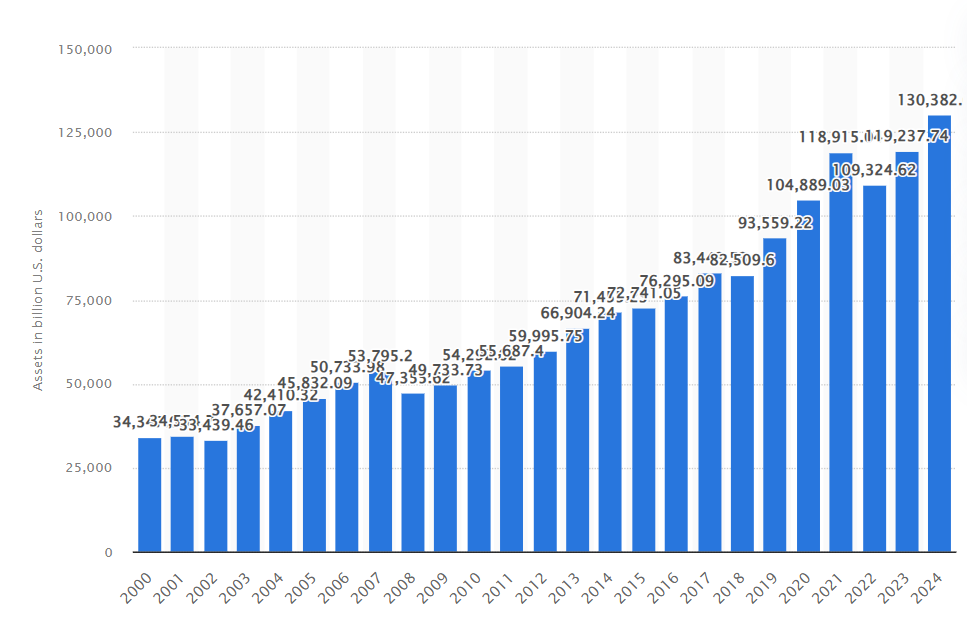
At the same time, the unemployment rate has remained low, credit spreads are still tight, and profit margins have remained elevated.
So, where does this leave us?
In a situation where it will pay to not get too comfortable. To take a team player mentality. To be like Josh Allen and Steph Curry instead of Dustin Johnson and Cam Smith. To strongly consider who is depending on you and the portfolio (or business) you manage, be it your firm, clients, colleagues, investors, partners, or family.
This means realizing that your portfolio’s (or business’s) success has likely benefitted from a very strong tailwind, but is now vulnerable and full of gains that could evaporate in the blink of an eye. Rebalancing and a thoughtful reallocation to assets (or parts of the business) that are cheaper, less risky, and/or out of favor may be prudent at this time.
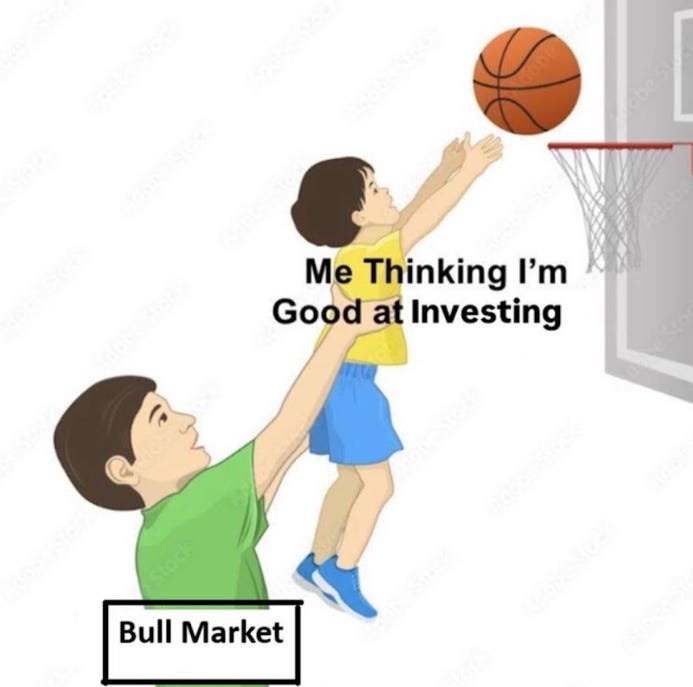
When it comes to the companies or funds you invest in, look for those with strong cultures, widely dispersed equity, and a demonstrated history of navigating through cycles. Those with leaders who have faced their employees during difficult moments and led them to the other side. Leaders like J.P. Morgan CEO, Jamie Dimon, who navigated his firm through the financial crisis better than anyone and explained part of the reason why, saying,
“Our clients know that we are there for them, are steady, do a good job for them, and that we earn a fair share for ourselves for doing so, which is critical.”
The fact is, a strong economy and market is a great thing. Something we should all be thankful for because it almost always leads to things like higher standards of living and GDP per capita. This said, like a pendulum, the behavior associated with a bull market can swing too far. As a result, those who benefit the most can wrongly attribute this success to skill rather than luck. In doing so, when markets eventually crack, like Dustin Johnson’s world ranking, a portfolio’s value can drop materially in a relatively short period of time.
The fact is, today, institutional portfolios are loaded with equities (both public and private) and 401k participation has never been higher, leading to more than 65% of Americans have some exposure to U.S. equities. This has led to a material rise in private equity valuations and an S&P 500 that currently stands at 23x price-to-earnings. The trouble is that over the past century, any dollars invested at these levels have produced near-zero returns over the subsequent decade (ranges from -2% to 2% annually).
The ironic part about investing is that the times that feel the best are often when portfolios are most vulnerable — while the moments that feel the worst are actually when they are most secure. Said another way, don’t get too comfortable right now. Unlike the LIV Golfers, nothing is guaranteed.
S&P 500 Price/Earnings Ratio (100 Years):
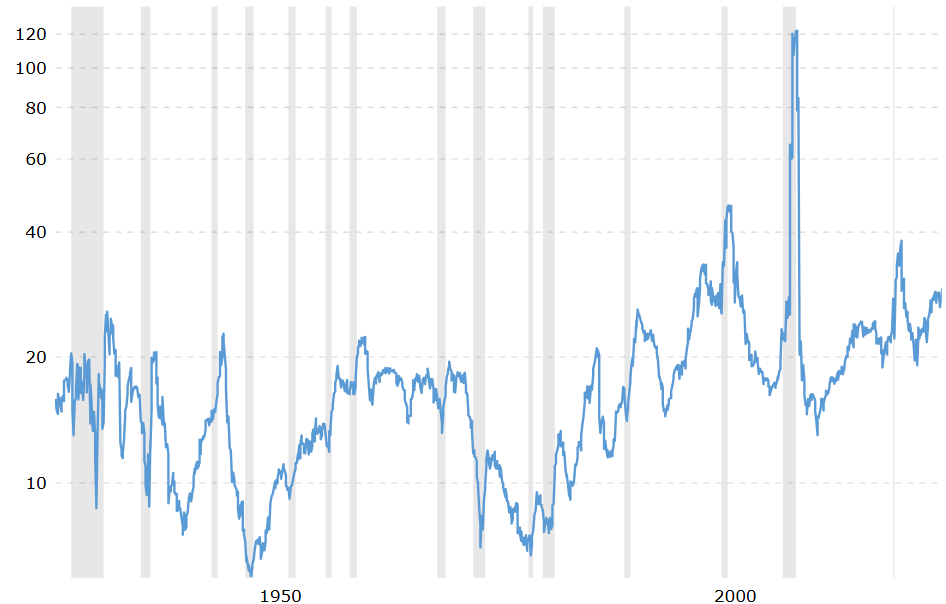
2025-08-14 05:54:00
A few things I’ve come to terms with:
There is rarely more or less economic uncertainty; just changes in how ignorant people are to potential risks.
You should obsess over risks that do permanent damage and care little about risks that do temporary harm, but the opposite is more common.
The only way to build wealth is to have a gap between your ego and your income.
Everyone belongs to a tribe and underestimates how influential that tribe is on their thinking.
A lot of financial debates are just people with different time horizons talking over each other.
It’s easy to mistake “I’m good at this” with “Others are bad at this” in a way that makes you overestimate how valuable your skills are.
It’s important to know the difference between rosy optimism and periods of chaos that trend upward.
If your expectations grow faster than your income you’ll never be happy with your money no matter how much you accumulate.
The inability to forecast the past has no impact on our desire to forecast the future. Certainty is so valuable that we’ll never give up the quest for it, and most people couldn’t get out of bed in the morning if they were honest about how uncertain the future is.
Having no FOMO might be the most important investing skill.
Few things are as valuable in the modern world as a good bullshit detector.
Most of what people call “conviction” is a willful disregard for new information that might make you change your mind. That’s when beliefs turn dangerous.
People have vastly different desires, except for three things: Respect, feeling useful, and control over their time. Those are nearly universal.
The market is rational but investors play different games and those games look irrational to people playing a different game.
There’s a sweet spot where you grasp the important stuff but you’re not smart enough to be bored with it.
A big takeaway from economic history is that the past wasn’t as good as you remember, the present isn’t as bad as you think, and the future will be better than you anticipate.
Most assholes are going through something terrible in their life. People hide their skeletons, which requires blind forgiveness of their quirks and moods because you’re unaware of what they’re dealing with.
History is driven by surprising events but forecasting is driven by obvious ones.
Pessimism always sounds smarter than optimism because optimism sounds like a sales pitch while pessimism sounds like someone trying to help you.
Every past decline looks like an opportunity and every future decline looks like a risk.
A comforting delusion is thinking that other people’s bad circumstances couldn’t also happen to you.
For many people the process of becoming wealthier feels better than having wealth.
Something can be factually true but contextually nonsense. Bad ideas often have at least some seed of truth that gives their followers confidence.
Every market valuation is a number from today multiplied by a story about tomorrow.
Comedians are the only good thought leaders because they understand how the world works but they want to make you laugh rather than make themselves feel smart.
People learn when they’re surprised. Not when they read the right answer, or are told they’re doing it wrong, but when they experience a gap between expectations and reality.
People tend to know what makes them angry with more certainty than what might make them happy. Happiness is complicated because you keep moving the goalposts. Misery is more predictable.
Getting rich and staying rich are different things that require different skills.
Money’s greatest intrinsic value is its ability to give you control over your time.
Past success always seems easier than it was because you now know how the story ends, and you can’t unremember what you know today when trying to remember how you felt in the past.
“Learn enough from history to respect one another’s delusions.” -Will Durant
There’s more to learn from people who endured risk than those who seemingly conquered it, because the kind of skills you need to endure risk are more likely repeatable and relevant to future risks.
Nothing too good or too bad stays that way forever, because great times plant the seeds of their own destruction through complacency and leverage, and bad times plant the seeds of their own turnaround through opportunity and panic-driven problem-solving.
Most people can afford to not be a great investor. But they can’t afford to be a bad investor.
What money can and can’t do for you isn’t intuitive, so most people are surprised at how they feel when they suddenly have more or less than before.
Your personal experiences make up maybe 0.00000001% of what’s happened in the world but maybe 80% of how you think the world works.
Unsustainable things can last longer than you anticipate.
“The thing that is least perceived about wealth is that all pleasure in money ends at the point where economy becomes unnecessary. The man who can buy anything he covets, without any consultation with his banker, values nothing that he buys.” - William Dawson
Napoleon’s definition of a military genius was “The man who can do the average thing when everyone else around him is losing his mind.” It’s the same in business and investing.
It’s hard to tell the difference between boldness and recklessness, greed and ambition, contrarian and wrong.
Woodrow Wilson talked about whether something was accountable to Darwin or accountable to Newton. It’s a useful idea. Everything is accountable to one of the two, and you have to know whether something adapts and changes over time or perpetually stays the same.
Risk has two stages: First, when it actually hits. Then, when its scars influence our subsequent decisions. The recession, and the lingering pessimism that does as much damage.
Tell people what they want to hear and you can be wrong indefinitely without penalty.
Optimism and pessimism always overshoot because the only way to know the boundaries of either is to go a little bit past them.
Reputations have momentum in both directions because people want to associate with winners and avoid losers.
It’s easier to lie with numbers than words, because people understand stories but their eyes glaze over with numbers. As the saying goes, more fiction has been written in Excel than Word.
It’s easy to take advantage of people. It’s also easy to underestimate the power and influence of groups of people who have been taken advantage of for too long.
You have five seconds to get people’s attention. Books, blogs, emails, reports, it doesn’t matter – if you don’t sell them in five seconds you’ve exhausted most of their patience.
It always looks like we haven’t innovated in 10 or 20 years because it can take10 or 20 years before an innovation is an obvious success.
When and where you were born can have a bigger impact on your outcome in life than anything you do intentionally.
Most people are good at learning facts but not great at learning rules – the broad lessons from events that will apply to future events.
Everyone is making a bet on an unknown future. It’s only called speculation when you disagree with someone else’s bet.
There are two types of information: stuff you’ll still care about in the future, and stuff that matters less and less over time. Long-term vs. expiring knowledge. It’s critical to identify which is which when you come across something new.
The same traits needed for outlier success are the same traits that increase the odds of failure. The line between bold and reckless is thin. So be careful blindly praising successes or criticizing failures, as they often made similar decisions with slightly different levels of luck.
When communicating, “know your audience” easily becomes “pander to your audience.”
Most financial mistakes come when you try to force things to happen faster than is required. Compounding doesn’t like when you try to use a cheat code.
There is an optimal net worth for most people, after which not only does happiness stop increasing but more money becomes a social and psychological liability. The number is different for everyone, but is probably lower than most people think.
Risk is what you can’t see, think only happens to other people, aren’t paying attention to, are willfully ignoring, and isn’t in the news. A little surprise usually does more damage than something big that’s been in the news for months.
Innovation and economics can be miles apart. Twitter directly influences geopolitics between nuclear states and is worth half as much as Progressive Auto Insurance.
Risk management is less about how you respond to risk and more about recognizing how many things can go wrong before they actually do.
There is too much marketing (waving your arms) and not enough branding (building trust).
A lot of people don’t realize what bet they’re making. Maybe they thought they were betting on disruptive technology, but it turned out they were betting on low interest rates. Or they thought they were betting on alternative energy, but it turned out they were betting on subsidies and tax credits. Many bets don’t work not because your bet was wrong, but because you didn’t realize the bet you were making in the first place.
Housing is often a liability masquerading as a safe asset.
Asking what the biggest risks are is like asking what you expect to be surprised about. If you knew what the biggest risk was you would do something about it, and doing something about it makes it less risky. What your imagination can’t fathom is the dangerous stuff, and it’s why risk can never be mastered.
A lot of good writing makes points that people already intuitively know but haven’t yet put into words. It works because readers learn something new without having to expend much energy questioning whether it’s true. The alternatives are points that are obvious and well known (boring) or something that’s non-obvious and unknown (often takes too much effort to understand and impatient readers leave).
Emotions can override any level of intelligence.
Small risks are overblown because they’re easy to talk about, big risks are discounted and ignored because they seem preposterous before they arrive.
If you have an idea but think “someone has already done that,” just remember there are 1,010 published biographies of Winston Churchill.
No one is thinking about you as much as you are.
John D. Rockefeller was worth the equivalent of $400 billion, but he never had penicillin, sunscreen, or Advil. For most of his adult life he didn’t have electric lights, air conditioning, or sunglasses. Everything about wealth is circumstances in the context of expectations.
Read fewer forecasts and more history. Study more failures and fewer successes.
There is an optimal amount of bullshit in life. Having no tolerance for hassle, nonsense and inefficiency is not an admirable trait; it’s denying reality. Once you accept a certain level of BS, you stop denying its existence and have a clearer view of how the world works.
Most problems are more complicated than they look but most solutions should be simpler than they are.
About once a decade people forget that bubbles form and burst about once a decade.
If something is impossible to know you are better off not being very smart, because smart people fool themselves into thinking they know while average people are more likely to shrug their shoulders and end up closer to reality.
You can’t believe in risk without also believing in luck because they are fundamentally the same thing—an acknowledgment that things outside of your control can have a bigger impact on outcomes than anything you do on your own.
“Reality will pay you back in equal proportion to your delusion.” – Will Smith
Risk’s greatest fuels are leverage, overconfidence, ego, and impatience. Its greatest antidote is having options, humility, and other people’s trust.
Once-in-a-century events happen all the time because lots of unrelated things can go wrong. If there’s a 1% chance of a new disastrous pandemic, a 1% chance of a crippling depression, a 1% chance of a catastrophic flood, a 1% chance of political collapse, and on and on, then the odds that something bad will happen next year – or any year – are … pretty good. It’s why Arnold Toynbee says history is “just one damn thing after another.”
People suffering from sudden, unexpected hardship can adopt views they previously would have considered unthinkable.
It’s easiest to convince people that you’re special if they don’t know you well enough to see all the ways you’re not.
A large group of people can become better informed over time. But they can’t, on average, become more patient, less greedy, or more level-headed during periods of upheaval. That will never change.
Good ideas are easy to write, bad ideas are hard. Difficulty is a quality signal, and writer’s block usually indicates more about your ideas than your writing.
More people wake up every morning wanting to solve problems than wake up looking to cause harm. But people who cause harm get the most attention. So slow progress amid a drumbeat of bad news is the normal state of affairs.
Everything is sales.